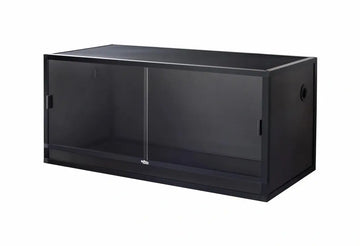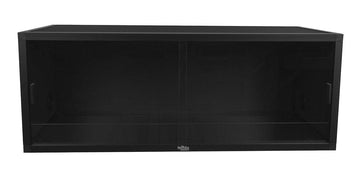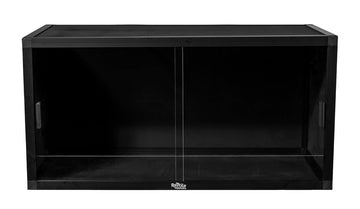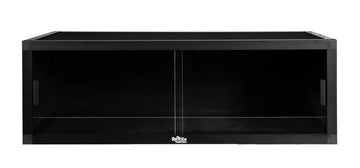The pancake tortoise (Malachochersus tornieri) is a 5-6” long tortoise native to Kenya and Tanzania. Their preferred habitat is arid savanna and scrub, always near plentiful rock cover.
Pancake tortoises are best known for the distinctively flat shells which give them their name. Instead of being highly domed and hard, pancake tortoise shells are thin, soft, and flexible, allowing them to avoid predators by squeezing into rock cracks. They are usually medium brown in color and may have a radiating pattern of lines on each scute.
Pancake tortoises are an intermediate-level pet reptile. With good care, you can expect a lifespan of at least 35 years for this pet.
Minimum enclosure size for pancake tortoises
Pancake tortoises can be kept indoors in a 3’L x 2’W x 2’H terrarium or larger. Tortoise tables are not recommended for this species, as they need climbing materials, and the low walls of a tortoise table may result in escape and injuries.
An outdoor pancake tortoise pen should be at least the same dimensions, preferably larger. The walls should be made out of a smooth material to discourage escape via climbing, but it’s also a good idea to install an overhang on the inside of the wall to further safeguard against escape. You will also need to secure the enclosure against potential thieves and predators. If you live in a climate that experiences temperatures below 68°F, you will need to provide temporary indoor housing for the winter and a dry, heated “tortoise barn” as part of the outdoor enclosure.
Cohabitation (housing multiple animals in one enclosure) is optional, but do not house males and females together unless you intend to breed them. Males should not be housed together, as they may fight and injure one another.
Do pancake tortoises need UVB?
Yes, pancake tortoises require exposure to UVB in order to maintain good health. Pancake tortoises housed outdoors do not need artificial UVB lighting, as they get all the UVB they need from exposure to sunlight. Pancake tortoises housed indoors, however, do need artificial UVB lighting.
The best UVB bulbs for pancake tortoises are:
- Arcadia T5 HO 12%
- Zoo Med T5 HO Reptisun 10.0
The bulb should be roughly half the length of the enclosure and mounted in the Arcadia ProT5 or Vivarium Electronics fixture. Place the lamp 14-17” above the tortoise’s shell to achieve the right strength for your tortoise. If there is mesh between the lamp and the tortoise, then this distance should be reduced to 10-12”, as mesh partially blocks UVB wavelengths.
Since pancake tortoises are diurnal and native to arid habitats, indoor enclosures require more illumination than just a UVB bulb can provide. Use a 6500K LED or T5 HO fluorescent grow light for this purpose.
Lights should be on for 12 hours/day.
Best temperature for pancake tortoises
Like other reptiles, pancake tortoises are cold-blooded, which means that they rely on external temperatures to manage their own body temperature and metabolism. A reptile’s enclosure should offer a range of temperatures to allow them to thermoregulate effectively.
Pancake tortoises housed outdoors should have access to a warm climate that does not drop below 68°F at night. Part of the enclosure should be shaded so the tortoise can escape the sun as needed. If night temps drop below 68°F, you will need to build a heated tortoise “house” inside the enclosure for the tortoise to use.
Pancake tortoises housed indoors will need a halogen flood heat bulb to create a high-quality basking area. Basking surface temperature should be around 108°F. The temperature on the cool end of the enclosure should be between 70-75°F, although up to 80°F is acceptable. These temperatures should be measured with a temperature gun.
The heat lamp should be placed at the same height as the UVB lamp. Do not use ceramic heat emitters (CHEs), red bulbs, or blue bulbs, as these are not as effective. However, CHEs and radiant heat panels are appropriate for use at night when necessary.
Best humidity levels for pancake tortoises
Pancake tortoises do best in dry conditions (under 50% humidity), but they still need humid microclimates to use when required, especially when they’re young.
For pancake tortoises housed outdoors, the most important thing is to make sure that the enclosure is not perpetually moist or wet. Rainfall should be infrequent. Occasionally hosing down the shaded part of the enclosure or providing a shaded moist hide can be helpful in particularly dry climates.
For pancake tortoises housed indoors, provide a humid hide on the cool side, lined with moistened sphagnum moss or substrate. Humidity should be monitored via digital probe hygrometer, with the probe placed in the middle of the enclosure.
Best substrate for pancake tortoises
Pancake tortoises need a substrate/bedding that replicates their natural habitat. For tortoises housed outdoors, what you already have in your yard should be fine. However, if you have perpetually moist soil, then it’s best to excavate the soil at least 12” down and replace it with a drainage layer and sandy soil.
Plain topsoil mixed 60/40 by volume with play sand works well as an indoor or outdoor substrate. It should be at least 3” deep and completely replaced every 3-4 months in indoor enclosures. Remove poop and urine daily.
How to decorate a pancake tortoise enclosure
An empty enclosure makes for a bored tortoise, reducing its quality of life. Keep your pet entertained and engaged with its environment with the strategic use of décor items that encourage it to exercise natural behaviors!
Although tortoises are generally poor climbers, pancake tortoises are a noteworthy exception! With particularly mobile limbs, they are expert climbers, and should have access to a well-secured rock stack or similar for climbing. This provides exercise and also helps keep the tortoise’s nails filed down.
Here are some other décor ideas to consider:
- additional hiding places/burrows
- logs
- live, edible plants
- large, flat stones
The more stuff you add, the more functional your enclosure is likely to become! As an additional feature, you can shape the substrate into hills to create more environmental variety for your pet.
For outdoor enclosures, experts recommend planting a variety of drought-tolerant, edible weeds and grasses for the tortoise to graze on. Small shrubs also make for good shelters. The Tortoise Table is a helpful resource for figuring out which ones are safe to use.
What to feed to a pancake tortoise
Pancake tortoises are herbivores, which means that they need a high-fiber, plant-based diet to stay healthy. Variety is key to good nutrition, but your tortoise’s diet should still be about 90% grasses and weeds, and about 10% “salad” greens and vegetables. Flowers can be used as treats.
Safe grasses/leaves for pancake tortoises: lawn grass, mulberry leaves, grape leaves, hibiscus leaves, meadow hay, oat hay, orchard hay, timothy, clover, dandelion, nasturtium, geranium, coreopsis
Safe greens and vegetables for pancake tortoises: cactus pads, kale, collard greens, turnip greens, romaine lettuce, red lettuce
Edible flowers like nasturtium, dandelions, geranium, roses, and hibiscus are great to add for variety and extra vitamins. Do not use flowers from florists, as these are usually soaked in chemicals.
Offer food every day on a plate or tray to prevent substrate ingestion.
Supplements
You will also need calcium and vitamin supplements to prevent your tortoise from developing a potential deficiency. A little bit of Mazuri tortoise diet or Zoo Med Natural Grassland Tortoise Food makes a nutritious addition to your tortoise’s salad. You will also need a cuttlebone present in the enclosure at all times for calcium.
Water
Of course, don’t forget a water bowl! For drinking water, offer a shallow dish large enough for the tortoise to soak as desired. Hatchlings should be soaked (supervised) 1-2x/week. The water should be no deeper than their elbows.
Keep the water clean at all times and scrub the dish weekly with a reptile-safe disinfectant.
How to handle your pancake tortoise
Tortoises in general don’t like being handled, so it’s best not to pick up your tortoise unnecessarily. However, if you want to interact with your tortoise, try hand-feeding or giving it light rubs on the head or shell.
*This care sheet contains only very basic information. Although it’s a good introduction, please further your research with high-quality sources. The more you know, the better you will be able to care for your pet!
"African Pancake Tortoise" by ZakVTA is licensed under CC BY-NC-SA 2.0











